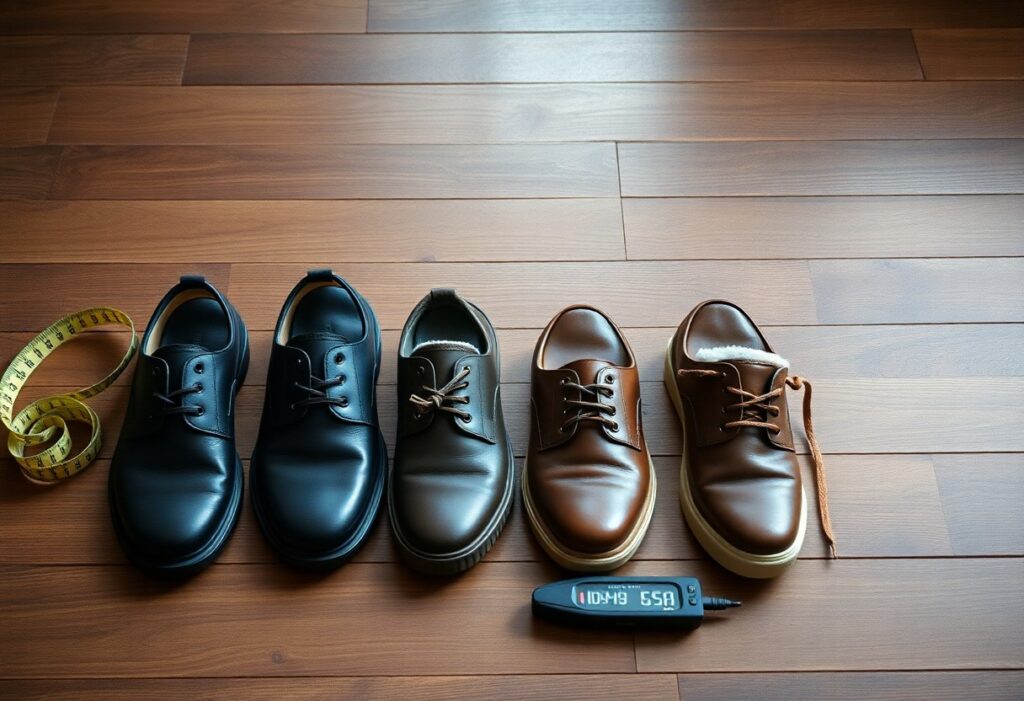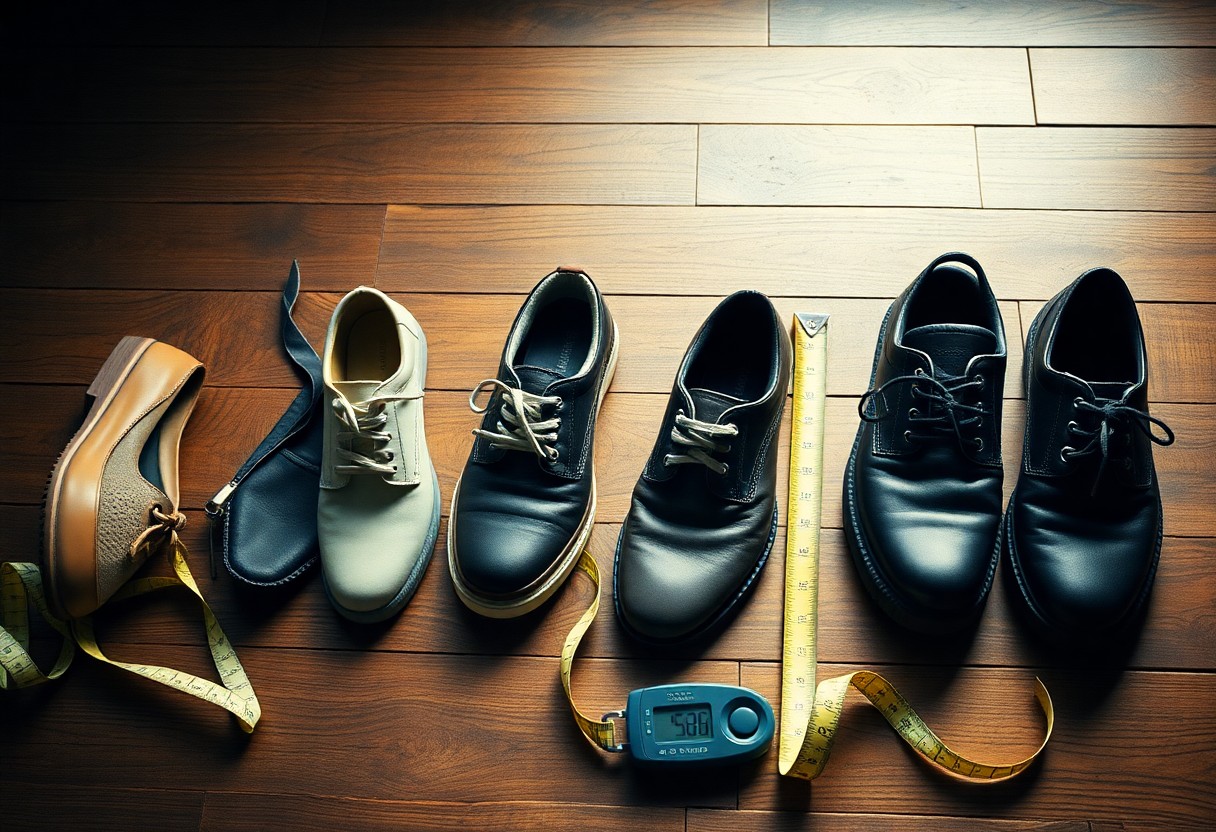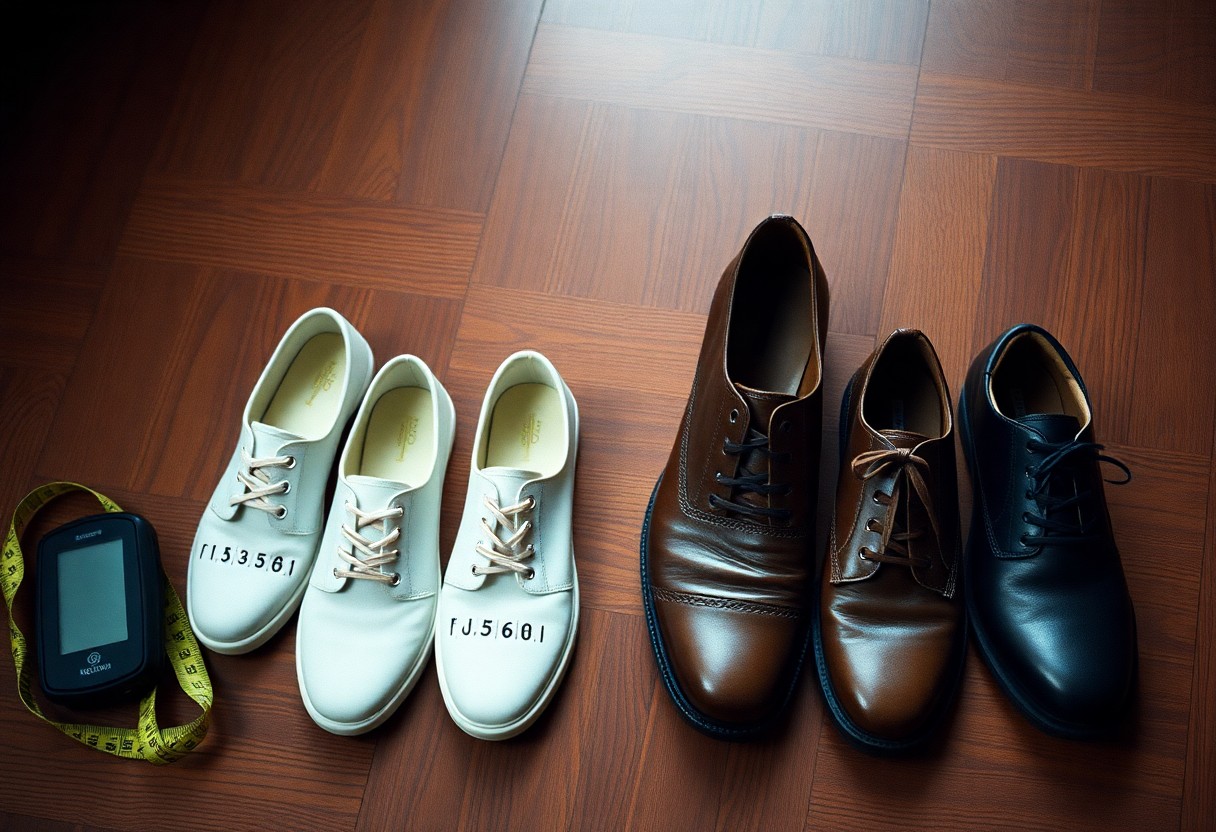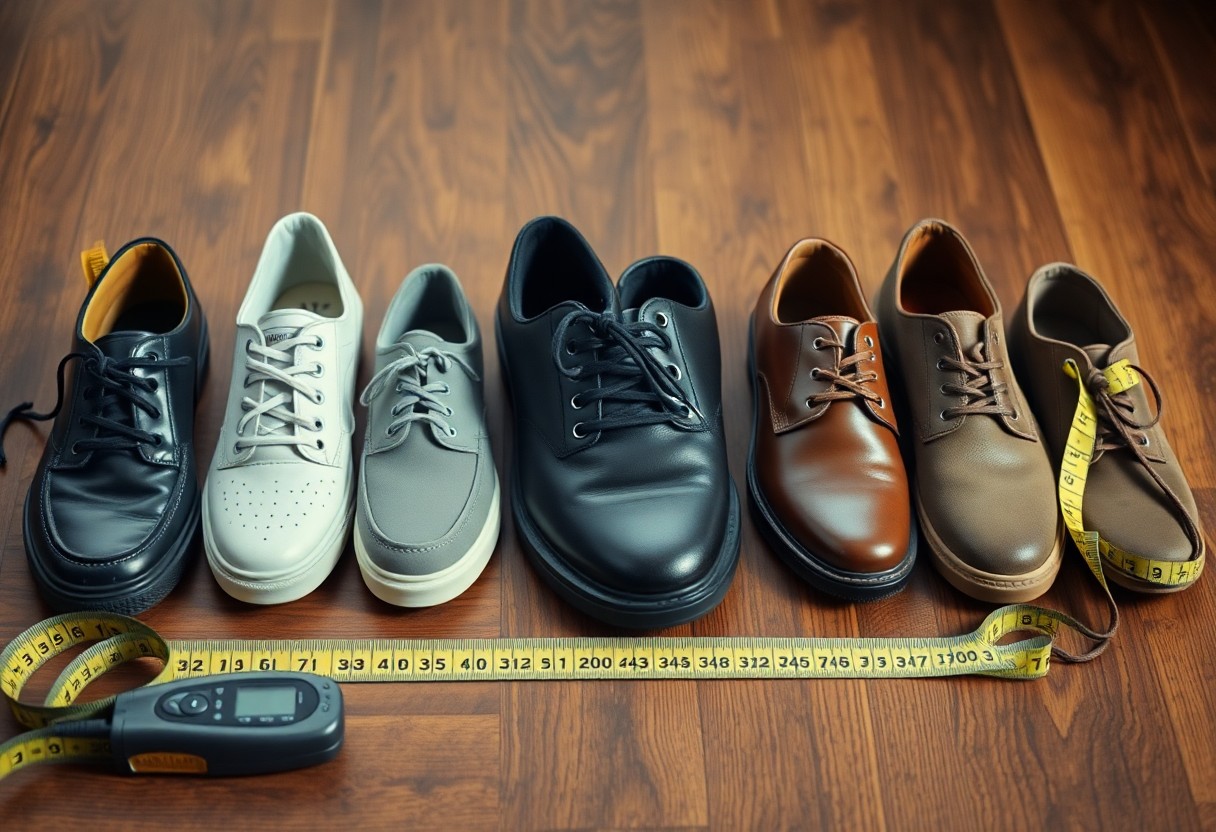
Grasping the importance of selecting shoes with the correct width is essential for maintaining optimal foot health. Wearing footwear that fits properly can significantly reduce foot discomfort and avert a variety of health issues. When searching for new shoes, it’s crucial to consider both the length and width to ensure a perfect fit. Selecting shoes with the right width can enhance your stability and improve blood circulation, while also minimizing the chances of developing blisters and other foot-related ailments. To find your ideal shoe width, measure the widest part of your foot and refer to standardized width charts. Many shoppers mistakenly concentrate solely on length, neglecting the fact that adequate width is just as important for daily comfort and overall foot health.
Learn How to Measure Your Feet for the Perfect Shoe Fit
The most effective method for determining your shoe width is to measure your feet in the late afternoon when they tend to be slightly swollen. Throughout the day, your foot width can fluctuate by as much as half an inch, making evening measurements the most reliable for achieving the best fit. To do this, stand on a sheet of paper and trace around your foot, ensuring you capture the most accurate measurement. This simple yet effective technique can help you find shoes that not only fit well but also provide the comfort and support your feet truly need.
Proven Techniques for Measuring Your Foot Width Accurately
In addition to using a standard ruler, consider employing a Brannock Device, a specialized tool found in most shoe stores, designed for precise foot size measurement. This device allows you to measure the widest part of your foot, typically located across the ball area. For optimal results, it’s essential to measure both feet while standing, as it’s common for one foot to be slightly larger than the other. This method ensures that you select shoes accommodating the larger foot, thereby preventing discomfort during wear.
Avoid These Common Mistakes When Choosing Shoe Width
One of the most prevalent mistakes made when selecting shoe width is neglecting the significance of width measurements. Many individuals zero in on length alone, which can lead to discomfort and various potential foot problems. Other frequent errors include measuring feet while seated and mistakenly believing that your foot width remains unchanged throughout your life. It’s crucial to recognize that wearing shoes that are too narrow can lead to serious foot ailments such as bunions, corns, and hammertoes. Factors such as weight changes, pregnancy, or aging can affect foot size; therefore, it’s advisable to measure your feet annually. Selecting the right width can play a significant role in preventing blisters, calluses, and chronic foot pain.

Navigate Shoe Width Systems and Standards for Optimal Fit
Becoming familiar with the various shoe width systems is essential for ensuring overall comfort and foot health. Different brands and countries employ distinct measurement standards, so understanding these systems can assist you in selecting shoes that fit well and prevent foot complications. By learning how width is categorized, you can make informed choices when selecting footwear that meets your specific needs.
Understanding Letter-Based Width Scales for Ideal Shoe Fit
When shopping for shoes, you will typically encounter widths labeled from AA to EE. For women, a medium width is classified as B, while for men, it is D. Narrow widths fall under AA to B, whereas wide widths range from D to EE. This letter-based system is designed to assist you in pinpointing the right fit based on your foot shape, ensuring that your shoes provide the necessary comfort and support.
Understanding International Width Measurement Standards and Their Importance
When shopping in the global market, you may encounter different measurement systems. For instance, European sizes are defined in millimeters, while UK sizes adhere to their unique width standards. Your US shoe size may vary from international measurements by one to two width sizes. Therefore, it’s vital to always consult the brand’s size chart when purchasing shoes from abroad. Japanese shoes tend to be narrower, whereas European brands often feature a wider toe box. To guarantee the best fit, measuring your feet in millimeters offers the most accurate reference for international purchases.

Comprehend How Shoe Construction Affects Fit and Comfort
To make the best choices for your footwear, it’s crucial to understand how shoes are constructed. A shoe’s build greatly influences how it fits and feels. Your overall comfort is significantly affected by the connection between the upper part of the shoe and the sole, along with the flexibility of materials used around the widest part of your foot. By opting for shoes with thoughtful construction, you can enhance your comfort and support throughout the day.
The Benefits of Natural Materials in Your Footwear Selection
Shoes made from genuine leather offer exceptional breathability and adaptability. Leather naturally stretches and molds to the contours of your foot over time, resulting in a personalized fit that enhances overall comfort. Research indicates that leather shoes can expand by as much as 30% of their original width, making them an ideal choice for individuals with varying foot widths who seek comfort and flexibility.
Durability and Consistency Offered by Synthetic Shoe Materials
Synthetic materials available today provide consistent width measurements and remarkable durability. These modern materials not only safeguard your feet but also deliver water resistance and enhanced breathability. Many synthetic shoes now incorporate mesh panels that improve airflow and flexibility. Additionally, advancements in synthetic materials have introduced comfort features such as memory foam and gel inserts. As a result, shoes can now merge stable width measurements with targeted cushioning, ensuring excellent support during wear. Recent studies have shown that synthetic materials can maintain their shape up to 40% longer than traditional materials, ensuring your shoes retain their proper width throughout their lifespan.

Identifying Signs of Proper Shoe Width for Ultimate Comfort
Unlike length, the correct shoe width is evident through how your feet feel and perform while wearing them. Your shoes should allow your toes to spread freely as you walk, with about half an inch of space at the widest part of the foot. Research shows that 70% of individuals wear shoes that are incorrectly fitted in terms of width, leading to various foot problems. Recognizing the signs of proper width can empower you to make informed footwear choices.
Key Indicators of Comfort from Correct Shoe Width
Here are crucial signs that your shoes fit correctly regarding width: your toes should be able to move freely, the ball of your foot should align with the shoe’s widest part, and there should be no pinching on the sides. A well-fitting shoe permits your feet to expand naturally throughout the day, as feet can swell by up to 8% by the end of the day.
Warning Signs That Indicate Incorrect Shoe Width
While using your shoes regularly, it is vital to remain vigilant for warning signs such as numbness or tingling in your toes, blisters on the sides of your feet, and pressure marks on your skin after removing your shoes. These symptoms indicate that your shoes may be either too narrow or excessively wide for your feet. Proper width is essential for maintaining foot health, as research shows that poorly fitting shoes can lead to long-term foot complications. You should feel no pressure points while standing or walking; if you experience pain, redness, or if your foot spills over the edges of the shoe, it’s time to consider a different width for your footwear.
Understanding Width Variations Across Different Shoe Brands
Many shoe brands offer a range of width options, spanning from AA (super narrow) to 4E (extra wide). It’s important to understand that foot width can vary throughout the day, and studies indicate that up to 70% of individuals have different widths between their left and right foot. Recognizing these variations will aid you in selecting shoes that accommodate your unique foot shape and help prevent discomfort and potential foot complications.
The Impact of Brand Differences on Shoe Width Measurements
When comparing different brands, you may notice significant discrepancies in width measurements. A medium width in one brand might feel narrow in another. European brands typically have narrower fittings than American brands, while athletic footwear companies often provide the widest variety of options. It’s always advisable to try on shoes before purchasing, as sizes can vary considerably across different manufacturers.
The Role of Shoe Style in Width Fitting
The style of the shoe significantly influences how width accommodates your foot. Athletic shoes generally provide more flexibility in width compared to dress shoes, while sandals are designed to allow for a more natural width. Your foot width needs may change based on the shoe’s intended purpose and the activities you plan to engage in. Further analysis indicates that specific styles require particular width considerations. For instance, high heels necessitate a secure fit to prevent slipping, while work boots may require additional width to comfortably fit thicker socks. Running shoes should provide approximately half an inch of space between your longest toe and the shoe’s tip for optimal comfort and performance.
Identifying Special Width Needs for Unique Foot Characteristics
While standard sizing options exist, some individuals may require specific width accommodations. If you have conditions like bunions, flat feet, or experience swelling, wider shoes may be necessary. Additionally, foot width can change throughout the day, with studies suggesting a potential 4% increase in foot volume by evening. Recognizing these variations is vital for selecting shoes that remain comfortable throughout your daily activities.
Foot Conditions That Necessitate Special Width Accommodations
Special width needs often arise due to medical conditions. For individuals with diabetes, arthritis, or edema, it’s essential to wear shoes with extra width allowance for proper circulation. Healthcare professionals may recommend specific width measurements to avoid complications associated with these conditions. Studies indicate that 75% of individuals with foot conditions benefit from specialized width fittings, highlighting the importance of suitable footwear.
Activity-Specific Width Needs for Optimal Performance
An active lifestyle necessitates specific shoe widths for various activities. For example, your running shoes may require more width than your everyday footwear, while hiking boots need ample space to accommodate thicker socks. Athletes often benefit from shoes that are half a size to a full size wider for high-impact activities, allowing for necessary foot expansion during exertion. In activity-specific fitting, consider your foot’s natural movement patterns. During running, your feet can spread up to half a size wider. For sports that involve lateral movements, such as tennis or basketball, adequate width is critical to avoid foot strain and potential injuries. Your footwear choices should align with your activity level and individual foot characteristics.
Find Your Ideal Shoe Width for Lasting Comfort
The key to discovering your perfect shoe width lies in understanding proper measurement methods and available width options. By measuring your feet at their widest point, identifying your width category (which ranges from A to E), and selecting shoes that correspond to your measurements, you can ensure lasting comfort. Your shoes should fit snugly without causing pinching or sliding, allowing your toes the freedom to move naturally. By opting for the correct width and materials that cater to your feet, you can enjoy comfortable, well-fitting footwear that supports your daily activities.
Answers to Common Questions About Shoe Width
Q: How can I effectively measure my foot width at home?
A: To measure your foot width accurately at home, place your foot on a blank sheet of paper and trace its outline. Measure the widest part, typically found at the ball of your foot, using a ruler. It’s best to take measurements in the afternoon when your feet are at their largest. Don’t forget to measure both feet, as one may be wider than the other. Use these measurements to compare with shoe width charts provided by manufacturers to find the best fit.
Q: What are the standard width measurements for shoes?
A: Shoe widths generally use letter codes ranging from A to E. For women, the standard medium width is B, while for men, it’s D. Narrow widths are denoted by A and AA, while C and D indicate medium-wide for women. E and EE represent wide widths. Keep in mind that each brand may exhibit slight variations in their width measurements, so it’s wise to consult their specific size charts before making a purchase.
Q: How can I determine if my current shoes have the incorrect width?
A: Look for these indicators: red marks on the sides of your feet, numbness in your toes, blisters on your heels or sides, and shoes that slip off while walking. Your toes should have ample space to wiggle freely, and the ball of your foot should fit comfortably at the shoe’s widest part. If you feel pressure on the sides, it’s time to consider a wider shoe. Conversely, if your foot shifts side-to-side, you may need a narrower width.
The Article How to choose the right shoe width tips for a comfortable fit appeared first on My Shoes Finder
The Article Choosing the Right Shoe Width for Ultimate Comfort Was Found On https://limitsofstrategy.com
The Article Shoe Width for Ultimate Comfort: How to Choose Wisely First Appeared ON
: https://ad4sc.com


I really appreciate the emphasis on shoe width in your post—it’s something that often gets overlooked. I remember when I first learned how much of a difference it makes; I had been wearing shoes that were too narrow for years, and it led to all kinds of foot pain. When I finally measured my feet properly and found the right width, it was like a light bulb went off. I also love the tip about measuring in the afternoon; I had no idea that feet could swell and influence fit so much! It’s such a simple yet crucial part of shoe shopping. I’m curious if anyone else has stories about how finding the right width transformed their experiences with shoes. It seems like such an important discussion for overall foot health!
It’s interesting how something as seemingly minor as shoe width can have such a significant impact on our overall comfort and health. I can relate to your experience; I used to ignore the width as well and just focused on whether I liked the style or color of the shoes. It wasn’t until I started getting persistent discomfort that I realized the importance of fit.
You’ve touched on a key point that a lot of us overlook until something goes sideways. It’s so easy to get caught up in how a shoe looks—style, color, and the latest trends can feel like they carry more weight than they really do when it comes to our day-to-day comfort. I was in the same boat for a long time, thinking that as long as I liked how my sneakers looked, they were good enough.
“I completely understand—you’re not alone in that journey! If you’re looking to find the perfect fit for your footwear, check out this resource that can help you discover shoes tailored to your needs.”
https://oldicom.net/webilaro
It’s interesting to hear how your experience mirrors so many others. Finding the right shoe width can really be a game changer, and I think many people overlook it until they face discomfort or pain. It’s not just about having a shoe that fits. When shoes are too narrow, they can cause a range of issues, from blisters to more serious conditions like bunions or plantar fasciitis. It’s great to hear that you took the time to measure your feet properly and found a solution.
“Absolutely! It’s amazing how much the right fit can change everything. If you’re looking for more tips on finding the perfect shoe for your feet, check out this helpful resource!”
https://oldicom.net/webilaro
This post resonates deeply with me, as I’ve often experienced the consequences of ill-fitting shoes firsthand. Like many, I used to choose footwear based solely on length, thinking that as long as my toes had enough room, I was good to go. However, over the years, I’ve developed a keen awareness of how important width truly is.
It’s great to hear your experience with finding the right fit for shoes. Many of us have been in that same boat, thinking that as long as our toes aren’t crammed, we’re doing fine. But taking a deeper look into the whole structure of our feet really opens up a world of comfort that many people overlook.
I completely resonate with your insights on shoe width! I used to prioritize shoe length, thinking that just finding the right size would be enough. It wasn’t until I started experiencing persistent foot discomfort that I realized how crucial width is. Once I began measuring my feet properly, I discovered that I actually needed a wider fit than I had been purchasing. This small change made a significant difference in my overall comfort!